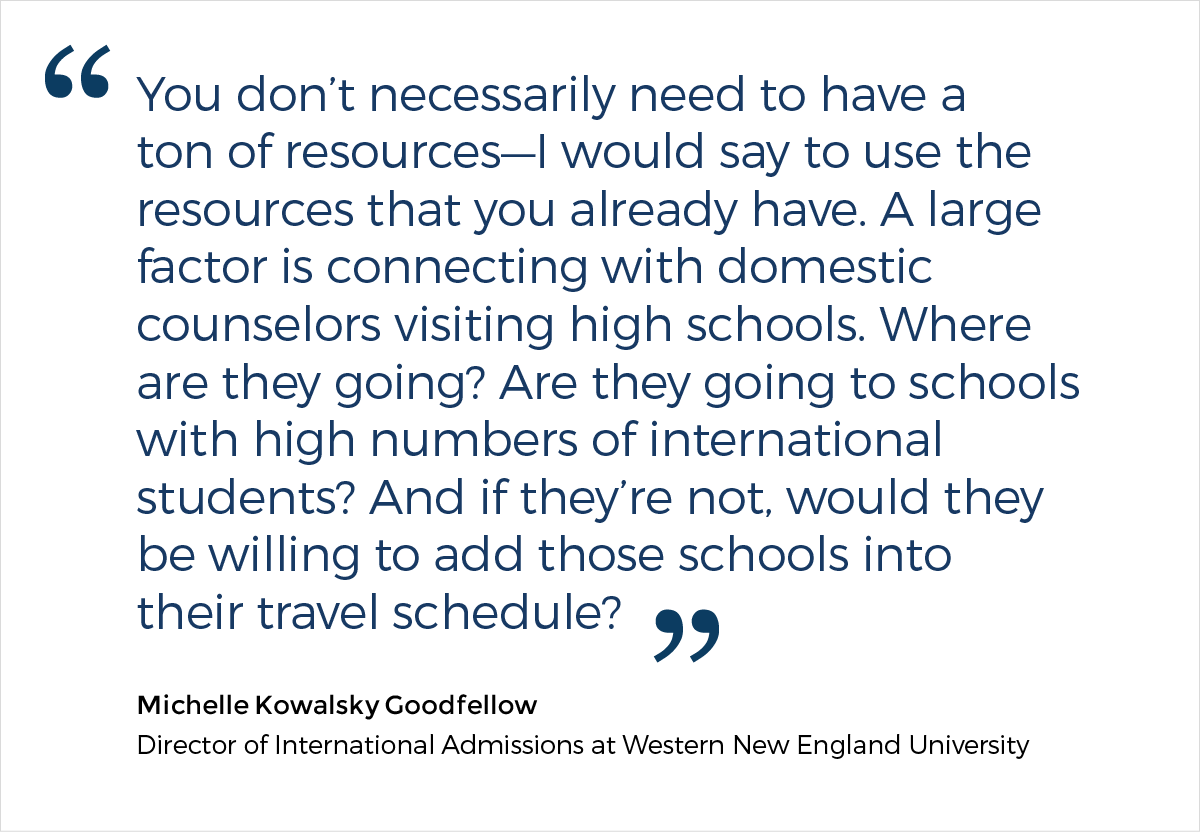Backyard Recruitment: Enrolling International Students Who Are Already in the United States
Cindy Le, Research Associate, WES
The 2016/17 school year marked the first time in 12 years that higher education institutions (HEIs) in the United States enrolled fewer new international students: Schools saw a 3.3 percent decline over the previous year. Student enrollments and applications are down for the majority of HEIs, and higher education experts expect the low numbers to continue. Steep losses from China and India, the two top sending countries for international students to the U.S., are of particular concern. These significant declines are causing HEIs to reconsider their traditional recruitment strategies and look for new methods to attract international students.
One such method is “backyard” recruiting. A method of recruiting international students already in the U.S., backyard recruiting finds students in high schools, community colleges, or pathway programs. In fact, 72 percent of institutions that WES surveyed earlier this year plan to increase domestic travel for the recruitment of international students for the upcoming recruitment cycle. To shed further light on the practice, WES interviewed a selection of HEI representatives who have experience with backyard recruiting strategies and best practices.
Why Recruit in Your Own Backyard?
Domestic recruitment offers HEIs significant international enrollment potential:
- Nearly 82,000 international students were enrolled in U.S. high schools in 2016; most planned to enroll in a U.S. HEI after graduation.
- Graduate schools have a substantially larger pool of students to recruit from, given the 439,000 international students enrolled at undergraduate institutions in 2017.
- More international students—many of whom plan to transfer to a four-year institution—are enrolling in the more than 50 pathway programs in the U.S. to improve their English.
- Community colleges host more than 8 percent of all international students in the U.S. as of 2017. Research shows, however, that many community college students who have high GPAs are still not transferring to four-year institutions, suggesting that there is room for recruitment to increase.
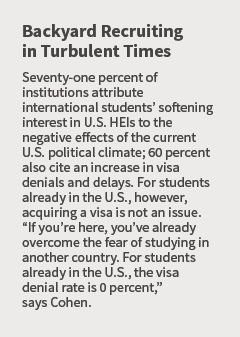 In fact, the number of international students in associate degree programs, the number of international high school students who have F-1 visas (which indicate that they are likely to complete their high school studies in the U.S.), and the number of international students studying intensive English in the U.S. equals 186,173 (See Figure 1). Compare that number to India alone, which sent 186,267 students for the 2016/17 school year. In other words, the potential of the U.S. as a source of international students is nearly equal to that of India—the second-largest source of inbound students.
In fact, the number of international students in associate degree programs, the number of international high school students who have F-1 visas (which indicate that they are likely to complete their high school studies in the U.S.), and the number of international students studying intensive English in the U.S. equals 186,173 (See Figure 1). Compare that number to India alone, which sent 186,267 students for the 2016/17 school year. In other words, the potential of the U.S. as a source of international students is nearly equal to that of India—the second-largest source of inbound students.
In addition to the sheer numbers of international students already in the U.S., domestic recruiting of international students is also cost-effective. While many schools are looking to try new recruitment strategies, 80 percent do not plan to increase their budget for the upcoming application cycle.
Recruiting from within the U.S. decreases the budget needed for more expensive recruitment methods, such as international travel, and may be an efficient way to reallocate resources. Eli Cohen, deputy director of International Student Recruitment and Marketing at John Jay College of Criminal Justice, notes, “Many schools spend a lot of money recruiting around the world, but it takes time to build up a name, and a lot of resources. If you don’t have the staff or the funding to do that, then you have to be creative. One of the best ways to do this is to figure out how to reach international students already studying in the U.S.”
With 19 percent of HEIs planning to do less overseas travel to recruit international students, this cost- and time-intensive recruitment method may be losing ground to more creative approaches, such as using social media or engaging international alumni.
Caroline Gear, executive director of the International Language Institute of Massachusetts, notes, “I think very often people tend to be always looking out, when you should be looking in. There are a lot of things you can be doing in your own backyard so that you can hopefully get more students and increase your marketing budget and be able to travel and continue to cultivate those local relationships.”
At a time when many schools are planning to lower or maintain their budget while increasing their international student recruitment numbers, backyard recruitment may be an effective strategy.
Sources for Domestic Recruitment
Local community colleges, intensive English language programs, and high schools where international students are enrolled are all potential sources for recruitment. These students have the added benefits of already having a student visa and English proficiency, and they are more acclimated to U.S. culture.
Community colleges are an obvious potential source, but four-year institutions can make it easier for international students attending community college to transfer into their programs by ensuring that students’ credits will transfer as well. English language programs in particular ensure that students possess sufficient English proficiency before attending a four-year institution.
“When an international student recruiter goes abroad, students of the target country don’t always have English proficiency,” says Vera Vlasenko, international student and scholar advisor at Westfield State University. “One of the options we can offer those students is enrolling with a language institute or another community college to bring their English proficiency up to a required level, but while they’re there we might lose them.” As a result, recruiting directly from the community college or language institute itself is a more reliable method of retaining international recruits.
According to the Institute of International Education, the number of U.S. secondary schools enrolling international students increased 22 percent from 2013 to 2016. Most of those students will, after they graduate, apply to U.S. HEIs. For students already in the U.S., a degree from a U.S. HEI is appealing.
“The majority of international students that go to community colleges and American high schools [are] here because they want to pursue an undergraduate degree at an American university,” Cohen says. “They’re just deciding which university.”
Many HEIs are already capitalizing on this inherent appeal by setting up formal programs to recruit international students.
Strategies for Backyard Recruitment
HEIs can approach the recruitment of international students already in the U.S. in a variety of ways. The following approaches are based on recommendations from international student recruitment experts.
Form Partnerships and Agreements
Partnerships with pathway programs—which are designed to ease students into university life and help them get acclimated to a new language and culture—are increasingly popular. More than 1,400 such programs exist both within and outside the U.S. for HEIs to partner with. Pathway partnerships give schools access to a wide pool of international students in addition to a network of recruitment agents, and can help a school develop its own recruiting infrastructure.
Schools can form partnerships with community colleges in their local area that are much like partnerships with pathway programs. One strategy for determining potential partners is to keep track of where students are transferring to and from. It is important to maintain these partnerships by establishing a point person, by frequently visiting the campus, and by evaluating the students who transfer from these institutions.1 Conferences such as NAFSA or EducationUSA may help with sharing information and resources with prospective students.
Many schools collaborate through a state consortium, such as Study Massachusetts, through which member schools can help promote each other’s strengths. “All of our partners offer something different,” says Gear, whose organization is a member.
Made up of peer institutions, a consortium can help its members with backyard recruiting by directing international students to its member schools and providing information. To maximize membership in a consortium, it is important to learn about the schools it comprises and the programs they offer. Vlasenko says, “Even though it’s a consortium, we’re not competing with each other—we are working together and collaborating.” If schools do not offer a specific program that a student is interested in, Vlasenko suggests, they can instead direct the student to another school within the consortium that might offer the program.
Conditional Acceptance Agreements
Conditional acceptance agreements are a key aspect of successful partnerships, especially those with ESL-specific schools or language institutes. Under a conditional acceptance agreement, graduates from sending institutions are not required to take additional English proficiency tests, such as the TOEFL.
By offering conditional acceptance agreements, four-year institutions gain access to a wider pool of international students and the language institutes and community colleges they attend. International students see these agreements as providing a clear path to a four-year degree, making the four-year institutions that offer them much more attractive. These students prefer having an up-front agreement to seeking admission at an institution without an agreement. They also prefer not having to submit English test scores. ESL schools and other language institutes are more receptive to representatives visiting their campus if four-year institutions are willing to waive the TOEFL requirement for their ESL students.2
Requiring a minimum GPA when designing a conditional acceptance agreement is helpful as well, suggests Michelle Kowalsky Goodfellow, director of International Admissions at Western New England University. “Because a student can pass a class with a D, but that student’s ability compared to a student who passed with a B or an A is drastically different,” she says. Including a minimum GPA will therefore help ensure that students are truly able to handle course work after transferring.
Developing strong relationships with language schools helps four-year institutions stay familiar with their methods and proficiency levels, and in turn allows HEIs to best decide how to support students as they transition to their institutions.3
Gear says, “I don’t refer students to schools I have not seen or where I don’t know the directors, or at least had a student who has had an excellent experience there,” emphasizing the importance of fostering beneficial relationships between language institutes and community colleges.
Reach Out to International Students
One of the main benefits of recruiting international students already in the U.S. is their ability to visit college campuses. Schools can host transfer fairs for ESL students or organize trips to campus. Such visits can involve tours and informational presentations on available programming and transfer options.4
“I think that one of the biggest benefits of domestic international recruitment is that you can bring students to you,” says Cohen. “We’ve invited students from all the different ESL schools across New York City to come to our campus and see what we’re all about.”
Maximize Your Resources
Engaging domestically focused recruiting counselors, who are often already doing tours of high schools, can help to supplement efforts to recruit international students. Domestic counselors often travel to a circuit of high schools, particularly private high schools where international students are often enrolled. Such counselors can be trained in basic information regarding international admissions. It may also be beneficial to tailor a presentation specifically to students who have F-1 visas.5
“The obstacle with high schools is really getting counselors trained so that they do not have that anxiety when it comes to international students,” says Kowalsky Goodfellow. For example, counselors can be trained to distinguish between international students and students who have permanent residency, or green cards.6 Assure domestic counselors that international staff is available to answer additional student questions, and to provide support, training, and resources when needed.
International admissions offices can also use their domestic counselor networks to create their own relationships with secondary schools by touring those schools themselves. These high schools will then become aware of the international admissions office and more comfortable with future communication.7
Schools’ existing networks can also be used to recruit from community colleges. “I use the relationships that the domestic territory managers have already built,” says Elizabeth “Betsy” Morley, director of International Recruitment at Albion College. “I’m usually going into a school and talking, not only to their counselors, but with whoever works with their international students. So I’m kind of expanding those relationships a little bit,” she says. Morley also works with the transfer admissions recruiter to identify potential international students and answer any questions.
Make Use of Agents
Everyone has an opinion about recruitment agents. Many believe that using agents can be detrimental to international student recruitment. Others believe that forming relationships with agents, however, can yield a positive outcome for both student recruitment and enrollment, while also achieving favorable results—that is, enrollment in a U.S. HEI—for students themselves.
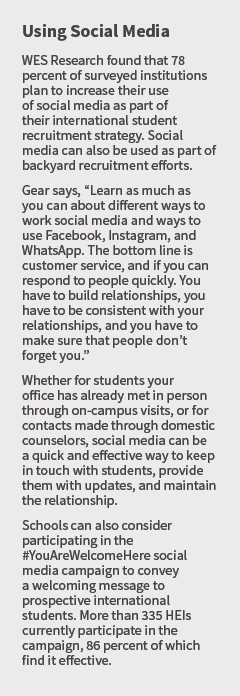 According to a recent WES research report, 52 percent of HEIs surveyed planned to increase their use of agents in their recruitment strategy in the 2017/18 cycle. Ignoring agents may hinder HEI international recruitment goals, since agents are common in terms of international student applications.
According to a recent WES research report, 52 percent of HEIs surveyed planned to increase their use of agents in their recruitment strategy in the 2017/18 cycle. Ignoring agents may hinder HEI international recruitment goals, since agents are common in terms of international student applications.
“Many of the international students that study at high schools in the U.S. definitely came from agents,” says Cohen, “and the agents don’t disappear from their lives. They’re not only going to help them find their high school, they’re going to help them choose a college, recommend who to work with or assist with tutoring and academic support, etc., so it’s very important to maintain relationships with these agents.”
Local agents are more likely to direct students to institutions that have developed relationships with them.8 In addition, good communication can smooth over any difficulties in the transfer process, such as a missing transcript or a request for additional information.9
Agents, like students, can be invited to campus so they can get a better sense of the institution. HEIs should consider hosting a professional development and agent workshop with partner schools as a way of introducing agents to their partners and vice versa.
“The best thing is for someone to see your campus, no matter what,” says Gear. “Whether it’s an agent, … a student, … a partner, they need that visual. By having good relationships with agents, schools can better serve students by providing them information on which agents and schools are the most highly recommended.”
Identifying agents can be difficult, but databases like the American International Recruitment Council’s Certified Agencies can be useful when starting out. Partnerships with other schools may result in shared resources and agent networks as well. For institutions that do not have these connections, ESL schools and language schools are good places to start; they often work with agents themselves and can help identify local agents.
Engage in Community Outreach
Interacting with the local community can help integrate and acculturate international students. It can also improve recruitment through word of mouth—the way the Lone Star College System in Texas attracts 95 percent of its international students.
“When you do these trips out into the community,” says Gear, “the community gets to know who you are, and maybe someone has a relative that they want to refer to your program.” She suggests several outreach methods: using press releases, organizing volunteer opportunities for students, inviting local guest speakers to campus, offering internship and work-study programs, hosting international festivals, connecting with homestay organizations, and planning local excursions to invite students to experience the wider local community.
Develop a Plan
A strategic plan is crucial to developing a backyard recruitment infrastructure. Strategic action plans should include long-term time frames, responsibilities, and measurable outcomes.10 Schools must also consider the profile of students they are trying to recruit before defining their goals and action plan.
Gear recommends the University of Kansas Community Tool Box, a website that provides free resources for developing a strategic plan. Schools should tailor their plans to their strengths and consider their location, the programs they offer, and cost. For example, recruiting locally might be a better option for a state school that is well-known in-state but relatively unknown elsewhere.
Morley says, “Selling an intensive English program that will bridge to a university or a large state school is much different than selling a small, intimate, residential liberal arts college.” When planning their recruitment strategy, schools can consider local events where university representatives can connect with area community colleges. This can include community college recruitment fairs through national organizations like EducationUSA, or local fairs such as the Greater Seattle International Transfer Fairs.
With international student enrollment declining and budgets tightening, backyard recruitment is a promising alternative to traditional international recruitment methods. International students already in the U.S. are eager to continue their education here. By developing mutually beneficial partnerships, utilizing available resources, and engaging with students, HEIs can reach domestic international students—and make the process positive for students and institutions alike.
1. Caroline Gear
2. Eli Cohen
3. Michelle Kowalsky Goodfellow
4. Vera Vlasenko
5. Eli Cohen
6. Elizabeth “Betsy” Morley
7.Michelle Kowalsky Goodfellow
8. Eli Cohen
9. Eli Cohen
10. Resources and Strategies for Promoting English Language Programs EducationUSA Forum 2017, provided by Caroline Gear
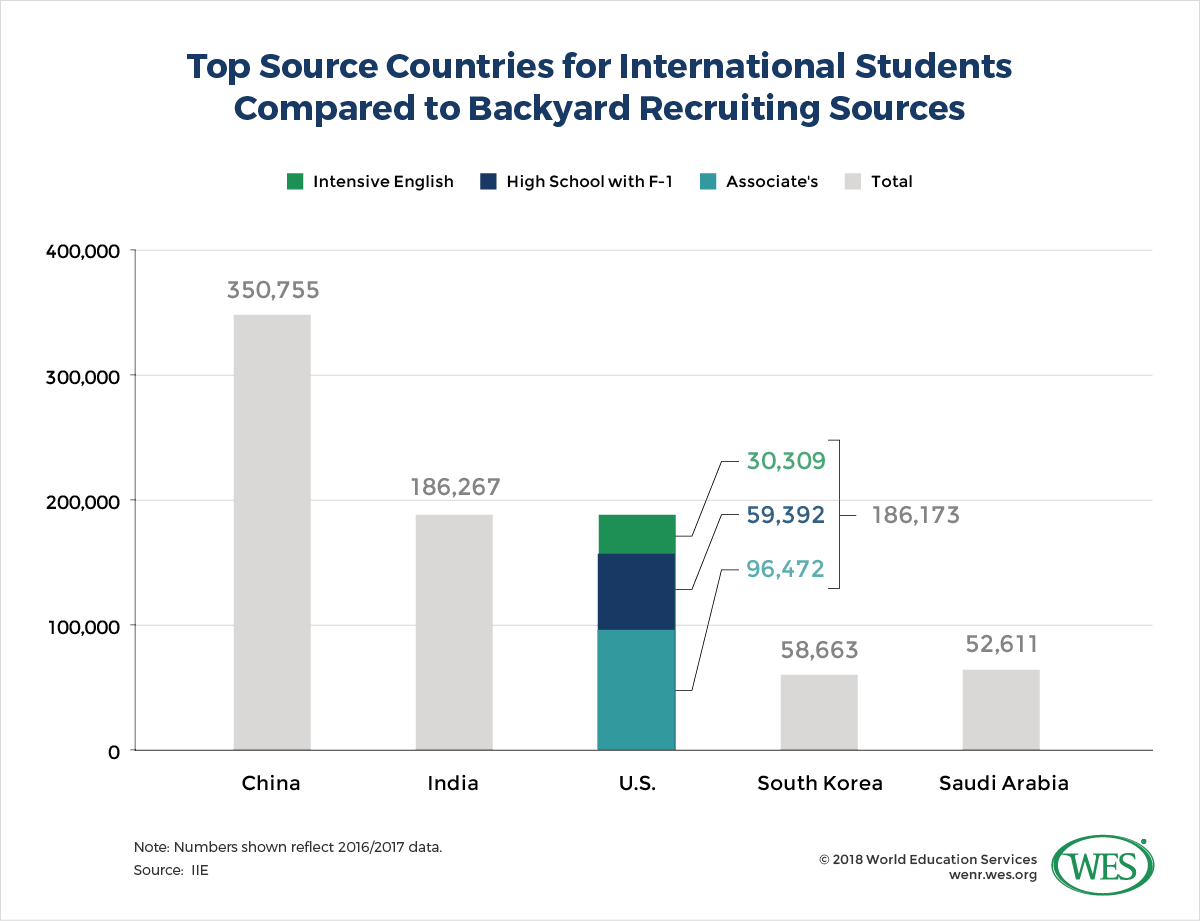
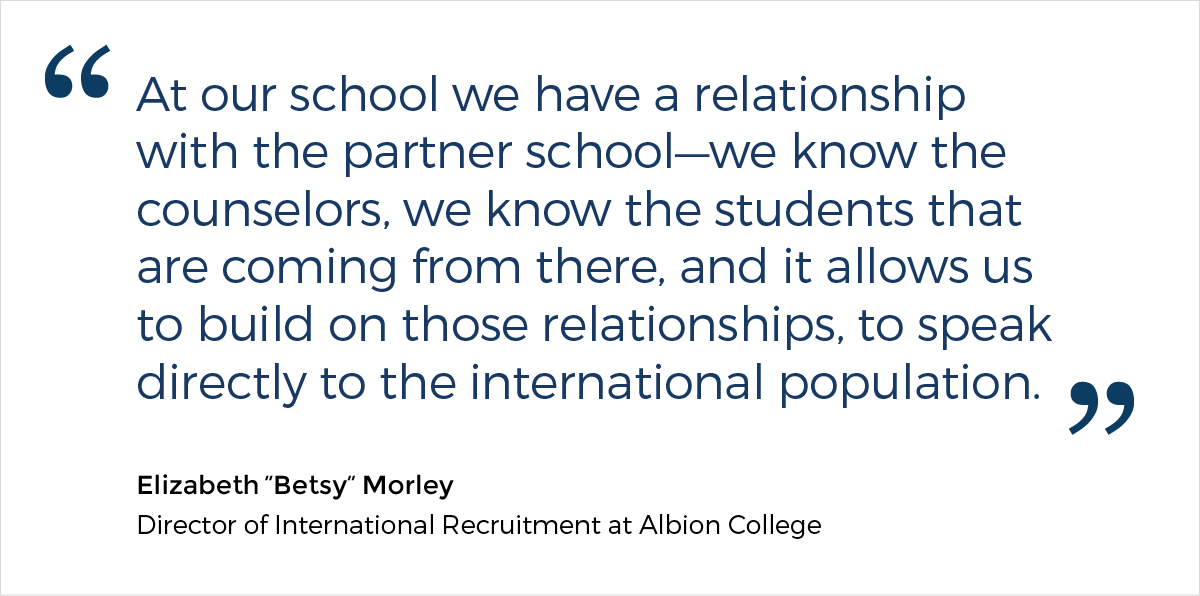
![A quote from Vera Vlasenko, an International Student and Scholar Advisor at Westfield State University, who says: "I created an articulation agreement with International Language Institute of Massachusetts in Northampton ... when we signed the agreement I represented my institution at the time [Greenfield Community College], and presented the opportunities that we could offer to international students—and the following morning five students showed up in my office and applied."](https://wenr.wes.org/wp-content/uploads/2018/10/WENR-1018-Backyard-Recruiting-4.png)
